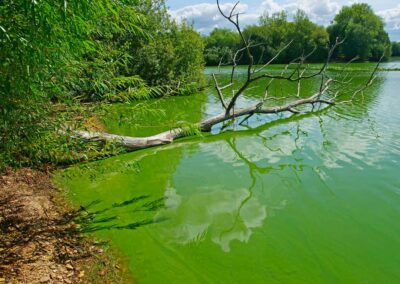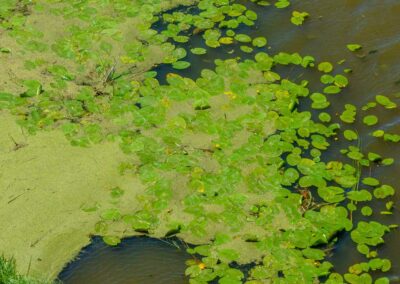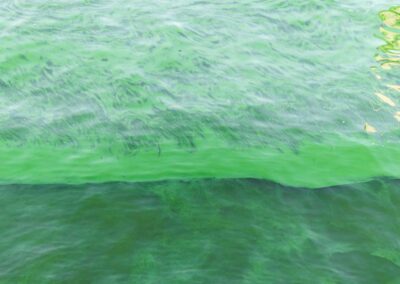HARMFUL ALGAE BLOOMS
(HABs)
How Do You Know If That Algae Is Toxic?
Problem
Harmful algal blooms (HABs) occur when certain types of cyanobacteria, also known as blue-green algae, grow rapidly. Since some HABs produce toxins, it is important to know if your water is safe when a bloom occurs. The only way to determine if a HAB outbreak is toxic and potentially dangerous to humans, pets, and wildlife is to test the water.
Identify
The first step to take when you think you have an HAB outbreak is to identify the bloom. See below for photo examples of some HAB varieties. Blooms can look like blue or green paint spilled into the water, a blue or green colored crust along the shoreline, thick puffy blue or green foams on the surface of the water (scums), or swirling colors beneath the surface of the water. Blooms can sometimes be white, brown, or red in color.
Cyanobacteria blooms can also have distinct smells. They can smell grassy or septic, and in some cases the smell can cause nausea. These cyanobacteria blooms can accumulate near the shoreline and can move based on wind and wave action. Long strands of green algae, duckweed, and filamentous macro-algae are sometimes confused with cyanobacteria blooms.
Solution
ILM offers a rapid response program that tests for the toxin microcystin, the most common HABs toxin produced by several kinds of cyanobacteria.
- Let us know you have an algae problem.
- Upon receiving your request, an ILM Aquatics Specialist will visit your site, take a water sample, identify the type of algae, and test for the presence of the microcystin toxin.
- You will receive the results within 36-48 hours. If the algae is proven toxic, we can create a plan to control the algae and restore water quality.
These algae only live for a few days to weeks. As algae cells die, the decomposition process uses oxygen in the water, often leading to low dissolved oxygen which can result in fish kills. Any control measures must be performed with caution if the body of water is in a moderate to heavy bloom phase.
If recurring HABs are an issue for your lake, ILM can help! By conducting a comprehensive assessment of your lake this summer, we can recommend proactive steps to minimize blooms in the coming years.







